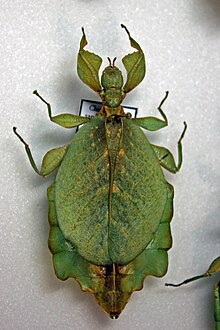This article has multiple issues. Please help improve it or discuss these issues on the talk page. (Learn how and when to remove these messages)
|
| Chitoniscus | |
|---|---|

| |
| Chitoniscus sarrameaesis adult female | |
| Scientific classification | |
| Domain: | Eukaryota |
| Kingdom: | Animalia |
| Phylum: | Arthropoda |
| Class: | Insecta |
| Order: | Phasmatodea |
| Family: | Phylliidae |
| Genus: | Chitoniscus Stål, 1875 |
Chitoniscus is a genus of leaf insects primarily found in tropical and subtropical regions, particularly in Melanesia and Australia. They inhabit dense forests, where they can camouflage themselves among the foliage of various plant species. Countries such as Australia, Fiji, Solomon Islands and New Caledonia are known to be home to Chitoniscus species.
These leaf insects prefer habitats with abundant vegetation, where they can feed on leaves and blend in seamlessly with their surroundings to avoid predators. They are typically active at night, feeding on leaves and mating underneath leaves. During the day, they remain motionless, resembling leaves to avoid detection by predators such as birds and small mammals.
Female insects typically exhibit a vibrant green hue, boasting wings that mimic delicate leaf veins and a broad, flat abdomen reminiscent of a leaf's shape. Their abdomens gracefully showcase a wavy pattern towards the lower segments. Primarily nocturnal, females are flightless and reproduce through either sexual or asexual egg-laying.
Conversely, males sport a longer, more slender physique, renowned for their agility. Their clear wings are larger in proportion. They exhibit the captivating wave-like pattern seen on the lower segments of the abdomen, akin to their female counterparts. Primarily nocturnal, males can fly and usually live less than females.
Species
- Chitoniscus brachysoma (Sharp, 1898)
- Chitoniscus erosus (Redtenbacher, 1906)
- Chitoniscus feejeeanus (Westwood, 1864)
- Chitoniscus lobipes (Redtenbacher, 1906)
- Chitoniscus lobiventris (Blanchard, 1853)
- Chitoniscus sarrameaensis Grösser, 2008
References
- "Chitoniscus Stål, 1875". Global Biodiversity Information Facility. Retrieved 14 March 2024.
- ^ Australia, Atlas of Living. "Species: Chitoniscus lobiventris (Lobed Leaf-Insect)". bie.ala.org.au. Retrieved 2024-03-14.
- ^ "species Chitoniscus lobiventris (Blanchard, 1853): Phasmida Species File". phasmida.archive.speciesfile.org. Retrieved 2024-03-14.
- Brock, Paul D.; Hasenpusch, Jack (2002). "Studies on the Leaf Insects (Phasmida: Phylliidae) of Australia". Journal of Orthoptera Research. 11 (2): 199–205. doi:10.1665/1082-6467(2002)011[0199:SOTLIP]2.0.CO;2. ISSN 1082-6467. JSTOR 3503696.
| Taxon identifiers | |
|---|---|
| Chitoniscus |
|
This Phasmatodea related article is a stub. You can help Misplaced Pages by expanding it. |